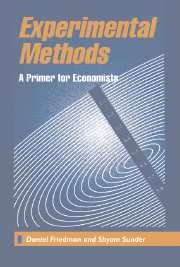Book contents
- Frontmatter
- Contents
- List of figures and tables
- Preface
- Acknowledgments
- EXPERIMENTAL METHODS
- 1 Introduction
- 2 Principles of economics experiments
- 3 Experimental design
- 4 Human Subjects
- 5 Laboratory facilities
- 6 Conducting an experiment
- 7 Data analysis
- 8 Reporting your results
- 9 The emergence of experimental economics
- Appendixes: Supplemental materials
- Glossary
- References
- Index
2 - Principles of economics experiments
Published online by Cambridge University Press: 05 June 2012
- Frontmatter
- Contents
- List of figures and tables
- Preface
- Acknowledgments
- EXPERIMENTAL METHODS
- 1 Introduction
- 2 Principles of economics experiments
- 3 Experimental design
- 4 Human Subjects
- 5 Laboratory facilities
- 6 Conducting an experiment
- 7 Data analysis
- 8 Reporting your results
- 9 The emergence of experimental economics
- Appendixes: Supplemental materials
- Glossary
- References
- Index
Summary
How do you choose and present the rules governing an experimental economy? How do you choose and motivate subjects? The principles presented in this chapter will provide some guidance. We begin with by discussing the relations between laboratory experiments, formal models, and reality, then informally present the key concepts of economic agents and economic institutions. (See Smith, 1976, 1982b for a more formal presentation using the framework of Hurwicz, 1972.) The next few sections present induced-value theory (again based on Smith, 1976). After a general discussion of external validity or parallelism, we highlight some practical implications and apply the ideas to an important strand of literature on market experiments.
Realism and models
Unless you already are an experienced experimentalist, your first instinct in designing an experiment probably will be to pursue realism – design the laboratory environment to resemble as closely as possible a real-world environment of substantive economic interest. If you are interested in securities markets, for example, you might have some subjects serve as investors, some as floor brokers, and some as specialists, all following the rules of the New York Stock Exchange.
On the other hand, if you are a theorist, your first instinct might be to design an experiment that replicates as closely as possible the assumptions of a formal model of interest. For the securities market example, you would throw out the brokers and specialists and the New York Stock Exchange rules, and perhaps ask your subjects to reveal their optimal demand/supply schedules to a (Walrasian) auctioneer.
Information
- Type
- Chapter
- Information
- Experimental MethodsA Primer for Economists, pp. 10 - 20Publisher: Cambridge University PressPrint publication year: 1994
